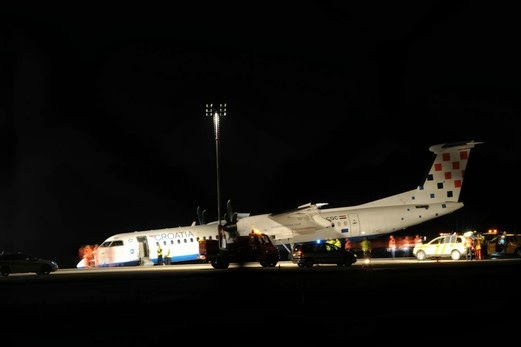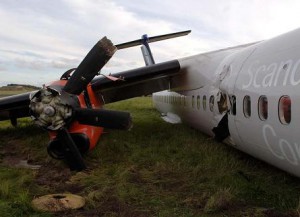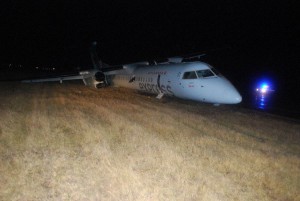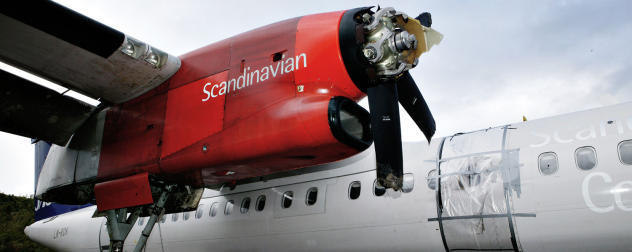The Dash-8-Q400 is the flagship of Bombardier’s turboprop products. Boasting powerful engines and a sleek body, it is designed to beat jets to reach 25,000 feet, and fly as fast as 350 knots true airspeed. It’s biggest competitor is fellow 60-seater the ATR-72, which is probably a prop pilot’s most hated propliner but is an accountant’s most loved propliner due to its lack of radical attempts to fly fast or climb fast, instead focusing on being boring and cheap to run. The sales number has shown that the ATR already won hands down. I looked at rough numbers and I can see why, but one thing I cannot help to wonder is, why is the Dash-8-Q400 “bad”?
Landing Gears
The bad reputation that sticks to the Q400 is the landing gear accidents from end of 2006 to end of 2007. The worst luck happened with SAS, within 3 days, 2 Q400s had the right main landing gear collapsing, followed by another a month later. SAS decided to discontinue the use of the Q400. The right main landing gear wasn’t the only problem at the time, Augsburg Air’s Q400 landed with the nose gear up.

The landing gear issues went on. ANA’s Q400 landed in Kochi without the nose gear. Porter Airlines had a Q400 whose landing gear failed to retract while another had to have the gear extension through alternate extension. To cap 2007 off, SAS had 2 cases of the landing gear failing to retract after take off.
These accidents were blamed on severe corrosion in the main landing gear, or a blocked hole within the actuator assembly, or corrosion of a spring. Bombardier itself were aware of problems, after the ANA case, it asked operators to check the front landing gear door mechanism. But others noticed the problems early on. In 2006, Japan’s Civil Aviation Bureau (JCAB) asked Bombardier to improve the reliability of the Q400 after 52 cases of Q400s declaring emergencies or returning to the departing airport. In 2007, the Accident Investigation Board of Denmark asked for the design, certification and the maintenance program of the Main Landing Gear mechanism to be reviewed. The FAA proposed an Airworthiness Directive in 2008 mandating changes to the weight-on-wheels mechanism and various other stuff. With all this, Bombardier had little choice but to introduce modifications.


However, on 7 November 2014, we saw a new case of a Q400 having the right main landing gear collapse upon landing. This time, it was due to a tire burst and bits of rubber were visible sticking to the landing gear extension/retraction mechanism. This case is still under investigation, but the landing gear collapse saw the propeller contact the ground and almost penetrated the fuselage, right next to a passenger. Perhaps it’s time Bombardier has another look at the landing gear design of the Q400?
Exit Doors
Given the high wings, ditching and evacuation on water seems to be a complicated matter for the Q400 which has 3 Type I doors (front left, rear left and right) and 1 type II/III exit on the forward right. Except the rear doors aren’t to be used in ditching.
The forward left door is equipped with a “ditching dam”, which prevents water from flooding the cabin (as the bottom of the door would be below the water line) and needs to be installed prior to opening the door. The forward right type II/III exit also has a ditching dam.
These ditching dams add extra complications and opens the potential for errors in a stressful evacuation, which I think contravenes the requirement for exits to be a simple and direct as possible. The sad thing is, these damns only slow the water coming in and not stop it.
Conclusion?
OK… so we have a plane who has a habit of the landing gear mechanism going funny, yet, if you land on water, you got fiddly stuff to deal with. I do wonder, does this justify calling the Dash-8 the “Crash-8”? If yes, then maybe the Dash-8-Q400 is the “Crash-8-Quit400”?
I guess it is not surprising that the ATR72 has made sales in Indonesia while the Q400 have not. I guess in the land where cost is everything, one can forego the benefits of the Q400, avoid the landing gear issue, the ditching issue (since Indonesia is a maritime country), and just play it safe with the boring ATR72.

